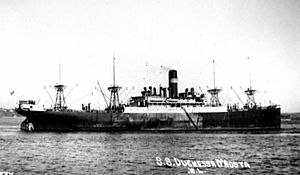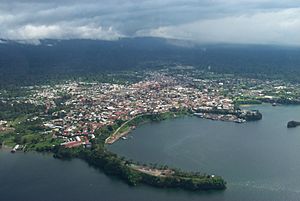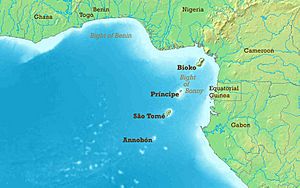Operation Postmaster facts for kids
Quick facts for kids Operation Postmaster |
|||||||
|---|---|---|---|---|---|---|---|
| Part of SOE operations and the Battle of the Atlantic | |||||||
 The Italian cargo liner Duchessa d'Aosta captured during the raid |
|||||||
|
|||||||
| Belligerents | |||||||
| Commanders and leaders | |||||||
| Strength | |||||||
| Small Scale Raiding Force 11 men Special Operations Executive 4 men local volunteers 17 men |
Duchessa d'Aosta ship's crew 46 Bibundi ship's crew unknown Likomba ship's crew unknown |
||||||
| Casualties and losses | |||||||
| None | 29 crew and one merchant ship with 2 boats captured | ||||||
Operation Postmaster was a secret mission carried out by the British during Second World War. It happened on the Spanish island of Fernando Po, which is now called Bioko. This island is located off the coast of West Africa.
The mission took place in January 1942. It was led by two special groups: the Small Scale Raiding Force (SSRF) and the Special Operations Executive (SOE). Their goal was to sneak into the harbor, take control of German and Italian ships, and sail them away to Lagos. The SSRF team, led by Major Gus March-Phillipps, traveled from Britain in August 1941. They sailed a fishing boat called Maid of Honour all the way to the Spanish colony.
At first, British officials in the area did not want the raid to happen. They thought it would break Spain's neutrality, meaning Spain was not taking sides in the war. However, permission for the operation finally came from the Foreign Office in London. On January 14, 1942, the raid began. The officers from the enemy ships were at a party set up by an SOE agent. While they were distracted, the British commandos entered the port using two tugboats. They quickly took over the ships' crews and sailed away with the vessels. One of the captured ships was the Italian cargo ship Duchessa d'Aosta. This daring raid greatly helped the SOE's reputation. It showed they could plan and carry out secret missions, even if there were political risks.
Why This Mission Was Needed
In 1941, the British Admiralty started getting reports. They heard that German submarines might be using rivers in parts of Africa controlled by Vichy France. These rivers could be secret places for the submarines to refuel.
The group chosen to check these reports was the Small Scale Raiding Force (SSRF). It was also known as No. 62 Commando. The SSRF was formed in 1941. It was a small team of 55 soldiers trained as commandos. They worked closely with the Special Operations Executive (SOE). Major Gus March-Phillipps was in charge of No. 62 Commando.
The Maid of Honour was a 65-ton fishing boat. It left Poole harbor on August 9, 1941. It was heading for West Africa. Five men were on board, led by March-Phillipps. The rest of the SSRF, led by Captain Geoffrey Appleyard, had left earlier on a troop transport ship. After six weeks of sailing, the Maid of Honour reached Freetown, Sierra Leone, on September 20, 1941. This was where both groups were supposed to meet. Appleyard's group had arrived earlier, in late August.
Once the Maid of Honour arrived, the search for German submarine bases began. They sailed into many rivers and deltas in the area. But they did not find any submarines or proof of a submarine base.
The SOE had agents in West Africa. Their job was to watch areas controlled by Vichy French, Spanish, and Portuguese forces. They wanted to find and stop any activities that could threaten Britain's colonies. While the commandos were looking for submarine bases, SOE agents learned about three ships. These ships were in the port of Santa Isabel. This port is on the Spanish island of Fernando Po. The island is about 30 kilometres (19 mi) off the coast of Africa. It is near the borders of Nigeria and Guinea.
The three ships were the Italian cargo ship Duchessa d'Aosta, the large German tug Likomba, and a diesel-powered barge called Bibundi. The Duchessa d'Aosta had a working radio. This was a danger because it could send information about Allied ship movements. The ship's captain refused to show all of its cargo details. This made people think it might also be carrying weapons or ammunition.
SOE agent Leonard Guise visited the island. He watched the ships. In August 1941, he suggested a plan to capture Likomba and disable Duchessa d'Aosta. The Admiralty approved this military operation in a neutral port on November 20, 1941.
To get the raiders to the island, two tugboats were provided. Their names were Vulcan and Nuneaton. The Governor of Nigeria, Sir Bernard Bourdillon, gave them. The raiding force would have 32 men. This included four SOE agents, 11 commandos from the SSRF, and 17 local men. The local men were hired to help crew the two tugs.
The mission faced a problem. The British General Officer Commanding (GOC) West Africa Command, General Sir George Giffard, refused to support it. He would not let the 17 local men join. He said it would mess up other plans he had. He also said the act would be seen as piracy and could cause trouble. Because of his concerns, the Admiralty stopped the operation. The Foreign Office and the British Embassy in Madrid also did not like the idea. They worried about how the Spanish government would react.
The final approval was given on January 6, 1942. The Foreign Office eventually supported it. They decided that even if Britain was suspected, there should be no clear proof. To be safe, the Admiralty sent HMS Violet, a Flower-class corvette. This warship would meet the captured ships at sea. This would create a cover story. The story would be that the ships were caught trying to sail back to Europe.
The Secret Mission Begins

SOE agent Richard Lippett got a job with a shipping company. This company, John Holt & Co (Liverpool), had offices on the island. Once he started working there, he began to prepare for the raid. He found out that the crew of Duchessa d'Aosta often went to parties on shore. They even had their own party on the ship on January 6, 1942. Lippett pretended to be a party-goer. This way, he learned important things about the ship. He found out if it was ready to sail, how many crew members were on board, and how the watch system worked.
The raiders left Lagos in their two tugboats on the morning of January 11, 1942. On their way, they practiced lowering small boats called Folbots. They also practiced boarding ships at sea. Captain Graham Hayes was in charge of this training. They reached Santa Isabel harbor. At 11:15 PM and 11:30 PM on January 14, 1942, both tugs were in position. They were about 180 metres (590 ft) outside the harbor.
On shore, Lippett had arranged a dinner party. The officers from Duchessa d'Aosta were invited. Twelve Italian officers and two German officers from Likomba attended.
The boarding teams got ready on the decks of the two tugs. They entered the harbor. The tug Vulcan, with March-Phillipps and Appleyard on board, headed for Duchessa d'Aosta. As they got closer, a few men were seen on the back deck of the cargo ship. They seemed to ignore the tug, only shining a flashlight in its direction. At the same time, small canoes called Folbots, led by Hayes from Nuneaton, paddled towards Likomba and Bibundi. These two ships were tied together. A watchman on Bibundi challenged them. They tricked him by saying it was the ship's captain coming back. The men from the canoes boarded Bibundi. The two watchmen on duty jumped into the water. After placing explosives on the anchor chain, the commandos guided Nuneaton next to Likomba. They were ready to tow Likomba and Bibundi.
As soon as they were ready, the explosives were set off. Nuneaton began to tow Likomba out of the harbor. Eleven men from Vulcan had managed to board Duchessa d'Aosta. One group put explosives on the anchor chains. Another group searched below deck and gathered prisoners. After blowing the anchor chains, Vulcan started to tow Duchessa d'Aosta out of the harbor.
The explosions woke up the townspeople. They started to gather on the pier. But no one tried to stop the ships from leaving. Several anti-aircraft guns fired at nothing, thinking the explosions were from an air attack. But the large six-inch guns protecting the harbor stayed silent. From entering the harbor to leaving with the ships, the whole operation took only 30 minutes. No one from the raiding party was hurt.
Out at sea on January 15, 1942, March-Phillipps set up watch schedules. He also placed guards on the 29 prisoners they had taken. That evening, they started having problems with the tugs' engines and the ropes towing the captured ships. The next day, Vulcan reached the meeting point. It was "captured" at sea by HMS Violet. Nuneaton had engine trouble. It managed to contact the Nigerian coal ship Ilorin using semaphore. The Ilorin then contacted Lagos, and another ship was sent to tow Nuneaton into port.
What Happened Next
The Special Operations Executive had now shown what they could do. They proved they could carry out missions, no matter the political risks. Hugh Dalton, the government minister in charge of SOE, told the British Prime Minister Winston Churchill about the raid's success. He also believed that "other neutral governments would be impressed that Britain would if needed disregard the legal formalities of war in their efforts to succeed." The SOE agent in charge of the Africa station wrote a report to the head of SOE, Colin Gubbins. He said that after the success of Postmaster, "perhaps next time it will not be necessary for prolonged negotiations before undertaking a 30 minute operation."
The Spanish government was very angry about the raid. They saw it as breaking their country's neutrality. The foreign minister Serrano Suner called the operation an:
intolerable attack on our sovereignty, no Spaniard can fail to be roused by this act of piracy committed in defiance of every right and within water under our jurisdiction. Do not be surprised, if we return the answer which the case demands—that of arms.
In Germany, radio stations reported that a "British destroyer had entered the harbor and dropped depth charges to blow up the anchor cables and the ship's crew were shot." The January 21, 1942, edition of Völkischer Beobachter published an article. Its headline was "British Denials – Admiralty Lies on Act of Piracy." British Naval Intelligence released their own statement:
In view of the German allegations that Allied naval forces have executed a cutting-out operation against Axis ships in the Spanish port of Santa Isabel, Fernando Po, the British Admiralty considers it necessary to state that no British or Allied ship was in the vicinity...As a result... of the German Broadcast, the British Commander-in-Chief dispatched reconnaissance patrols to cover the area. A report has now been received that a large unidentified vessel has been sighted, and British naval vessels are proceeding to the spot to make investigations."
The details of the raid were kept secret. Even the British Chiefs of Staff were only told on January 18, 1942. They were informed that Duchessa d'Aosta had been stopped 230 miles (370 km) offshore. It was being taken to Lagos.
On Fernando Po itself, Richard Lippett had stayed on the island. Spanish authorities questioned him on January 17, 1942. He managed to convince them he had nothing to do with the ships leaving. He also said he had not spent any money on the party for the ship's officers. He was released on January 27, 1942. But he was not allowed to leave the island. He finally left secretly by canoe. He arrived in British territory on March 1, 1942.
After the operation, the Maid of Honour was left in Lagos. It was later sold to the Sierra Leone government as a converted fishing boat. The Duchessa d'Aosta was sailed to Greenock. Then, Canadian Pacific managed it as the Empire Yukon for the Ministry of War Transport. Likomba was managed by the Elder Dempster Lines. They renamed it Malakel in 1947. Then they sold it to Liberia in 1948.
After the raid, March-Phillipps received the Distinguished Service Order. Hayes was given the Military Cross. Appleyard received a Bar to his Military Cross. Lippett and Guise were both made Member of the Order of the British Empire. Another commando, Private Anders Lassen, was the first person to board Duchessa d'Aosta. He was the only professional sailor on the raid. For his great skill in getting the ship moving, Lassen was made an officer in the field. He also immediately received the Military Cross.
March-Phillipps was killed during Operation Aquatint in September 1942. On the same mission, Hayes escaped capture. He crossed the Spanish border. But he was handed over to the Germans. They kept him alone for nine months. He was then executed by a firing squad on July 13, 1943. Appleyard later joined the Special Air Service. On the same day Hayes was executed, Appleyard was reported missing. His plane did not return from a mission. Lassen also joined the Special Air Service. He was awarded two bars to his MC. He was promoted to major before receiving a posthumous Victoria Cross in Italy in 1945.
Images for kids
-
Modern (2007) picture of Santa Isabel from the air







